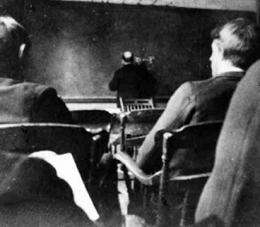The birth of electrical engineering

In September 1882, Thomas Edison opened the first commercial power plant in the United States, serving 59 customers in a square mile of Lower Manhattan. That same fall, MIT made electrical history of its own, with the establishment of the country’s first electrical-engineering curriculum.
Edison’s power plant was the latest in a flurry of electrical breakthroughs, beginning with the first successful transatlantic telegraph cable in 1866, the demonstration of the first working telephone in 1876 and Edison’s first light bulb in 1879. Still, the need for an autonomous discipline of electrical engineering was by no means obvious to the world at large. Indeed, the role of the engineering disciplines in general wasn’t obvious to the world at large. But a vision of that role had, in large part, animated the founding of MIT in 1861.
According to Paul Penfield, professor emeritus of electrical engineering, the idea of a technical university “seems so natural now that we tend to forget how radical it was at the time.” In their book, A Century of Electrical Engineering and Computer Science at MIT, 1882-1982, former electrical-engineering professor Karl Wildes ’22 and Nilo Lindgren ’48 describe William Barton Rogers’ 15-year struggle to get the Massachusetts legislature to approve his plan for a new polytechnic university. For the legislators, write Wildes and Lindgren, “it was probably difficult to distinguish the concept of the Institute from the trade schools already in existence.”
But as Penfield puts it, trade schools were intended to educate technicians, while MIT was founded to educate engineers. “Technicians use existing technology, and they do interesting things with it, and they make inventions, and so on,” Penfield says. “And scientists advance science. But the link between those two is engineers, who not only use existing technology but develop new technology using known science. And that was more or less the vision of the founding of MIT.”
Charles Cross, who created the electrical-engineering curriculum virtually single-handedly, was chair of the physics department. But having graduated from MIT 11 years earlier, as a member of only its third graduating class, he was steeped in the Institute’s philosophy. It was Cross who, in the early 1870s, invited the young Alexander Graham Bell to conduct some of his seminal acoustics experiments at MIT, and Bell would later say that Cross himself “made many advances in the telephone.” According to Wildes and Lindgren, by 1880, Boston had the highest rate of invention per capita in the United States: Cross was at the center of a welter of innovation. “There were not enough applications of electricity in the nation yet, but they were coming, and he could clearly see them coming,” Penfield says.
In 1882, one plausible objection to the introduction of an electrical-engineering curriculum could have been that the underlying science wasn’t mature enough. Edison’s power plant was a case in point: it used direct current instead of the alternating current championed by Nikola Tesla and George Westinghouse, which turned out to be much more practical in the long run. Wildes and Lindgren observe that, at the time, electrical inductance was so poorly understood that it was seen as an obstacle to telegraphic transmission, whereas the British electrical engineer Oliver Heaviside would soon demonstrate that, to the contrary, it was an important means of reducing distortion in telegraphic signals.
But in forging ahead anyway, Cross was again thinking like an engineer. “Engineers generally don’t wait around for the science to be fully developed before they want to make use of it,” Penfield says. “They’re basically tinkerers and inventors at heart, and they want to use this stuff. And if the science isn’t there, they’ll go ahead anyway.”
According to Wildes and Lindgren, the course load for the first few years of the electrical-engineering curriculum largely overlapped with that for the mechanical-engineering curriculum, which was one of three engineering curricula in place when the Institute opened its doors (the others were civil engineering and mining engineering). Reserved for the later years were classes on topics such as telephony, telegraphy and power transmission, but as Wildes and Lindgren point out, the substance of those classes had yet to be determined when the curriculum first appeared in the course catalogue. Within only 10 years, electrical-engineering students constituted 27 percent of the MIT student body — a percentage, Penfield says, that has stayed roughly consistent every since.
When asked why MIT, in particular, was so prescient in seeing the potential of electrical engineering as an autonomous discipline, Penfield, like a true engineer, opts for the most parismonious explanation. “It probably revolves around the interests of individual people,” he says. “Cross was a smart guy, and he recognized that an emerging technology would be important and that students would be interested in it, and he had the enthusiasm to go ahead and do it. I don’t know that it’s anything more than that.” Penfield pauses, then adds, “But of course, that is important, and that drives MIT now, also. A big part of the success of any university is the brains and the attitude of the people there.”
This story is republished courtesy of MIT News (), a popular site that covers news about MIT research, innovation and teaching.
Provided by Massachusetts Institute of Technology
















